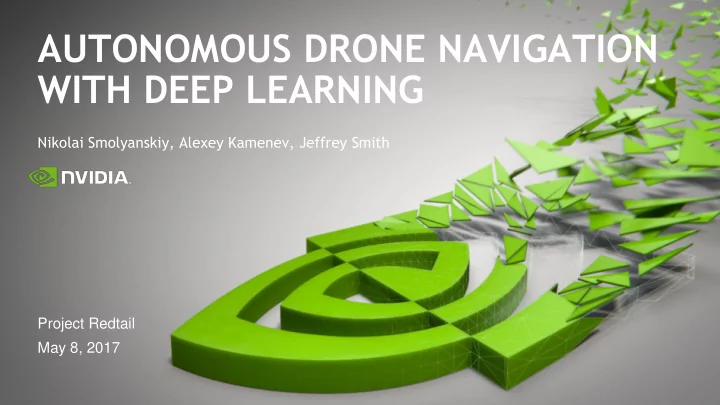

AUTONOMOUS DRONE NAVIGATION WITH DEEP LEARNING Nikolai Smolyanskiy, Alexey Kamenev, Jeffrey Smith Project Redtail May 8, 2017
100% AUTONOMOUS FLIGHT OVER 1 KM FOREST TRAIL AT 3 M/S 2
Why autonomous path navigation? Our deep learning approach to navigation AGENDA System overview Our deep neural network for trail navigation SLAM and obstacle avoidance 3
WHY PATH NAVIGATION? Drone / MAV Scenarios Industrial inspection Search and rescue Video and photography Delivery Drone racing 4
WHY PATH NAVIGATION? Land Robotics Scenarios Delivery Security Robots for hotels, hospitals, warehouses Home robots Self-driven cars 5
DEEP LEARNING APPROACH Can we use vision only navigation? NVIDIA’s end -to-end self-driving car Giusti et al. 2016, IDSIA / University of Zurich Several research projects used DL and ML for navigation 6
OUR PROTOTYPE FOR TRAIL NAVIGATION WITH DNN 7
SIMULATION We used software in the loop simulator (Gazebo based) 8
PROJECT PROGRESS 9
PROJECT TIMELINE Level of Autonomy 100% AI Flight 88-89% AI Flight 50% AI Flights, Oscillations, Crashes Forest Flights. Control and Outdoor DNN Flights. problems DNN Simulator Control Development Prototype Flights Problems August September October November December January 2017 February March April 10
100% AUTONOMOUS FLIGHT OVER 250 METER TRAIL AT 3 M/S 11
DATA FLOW Pixhawk TrailNet Steering Camera Autopilot DNN Controller Probabilities of: Next waypoint: Image Frame: 3 views: Left, Center, Right Position 640x360 3 positions: Left, Middle, Right Orientation 12
TRAINING DATASETS Automatic labelling from left, center, right camera views IDSIA, Swiss Alps dataset: 3 classes, 7km of trails, 45K/15K train/test sets Our own Pacific NW dataset: 9 classes, 6km of trails, 10K/2.5K train/test sets Giusti et al. 2016 13
HARDWARE SETUP Customized 3DR Iris+ with Jetson TX1/TX2 We use a simple 720p front facing webcam as input to our DNNs Pixhawk and PX4 flight stack are used as a low level autopilot PX4FLOW with downfacing camera and Lidar are used for visual-inertial stabilization 14
SOFTWARE ARCHITECTURE Our runtime is a set of ROS nodes ROS Camera Joystick TrailNet SLAM to compute Object semi-dense maps DNN Detection DNN Steering Controller PX4 / Pixhawk Autopilot 15
CONTROL Our control is based on waypoint setting 𝑏 = 𝛾 1 ( 𝑄𝑠 𝑤𝑗𝑓𝑥 𝑠𝑗ℎ𝑢 𝑗𝑛𝑏𝑓 − 𝑄𝑠 𝑤𝑗𝑓𝑥 𝑚𝑓𝑔𝑢 𝑗𝑛𝑏𝑓 ) + 𝛾 2 ( 𝑄𝑠 𝑡𝑗𝑒𝑓 𝑠𝑗ℎ𝑢 𝑗𝑛𝑏𝑓 − 𝑄𝑠 𝑡𝑗𝑒𝑓 𝑚𝑓𝑔𝑢 𝑗𝑛𝑏𝑓 ) 𝑏 − "𝑡𝑢𝑓𝑓𝑠𝑗𝑜" 𝑏𝑜𝑚𝑓 ; 𝛾 1 , 𝛾 2 − "𝑠𝑓𝑏𝑑𝑢𝑗𝑝𝑜" 𝑏𝑜𝑚𝑓𝑡 new waypoint / direction 𝑏 > 0 𝑢𝑣𝑠𝑜𝑡 𝑚𝑓𝑔𝑢, 𝑏 < 0 𝑢𝑣𝑠𝑜𝑡 𝑠𝑗ℎ𝑢 𝑏 old direction 16
TRAILNET DNN 1. Train ResNet-18-based network ( rotation only) using large Swiss Alps dataset S-RESNET-18 rotation (3) translation (3) conv4_x Output: 6 conv2_x conv3_x conv5_x Input: 320x180x3 2. Train translation only using small PNW dataset K. He et al. 2015 17
TRAILNET DNN Training with custom loss Classification instead of regression Ordinary cross-entropy is not enough: 1. Images may look similar and contain label noise 2. Network should not be over-confident C: 1.0 L:1.0 R:1.0 18
TRAILNET DNN Training with custom loss Loss: 𝒛: 𝑡𝑝𝑔𝑢𝑛𝑏𝑦 𝑝𝑣𝑢𝑞𝑣𝑢 𝑀 = − 𝑞 𝑗 ln 𝑧 𝑗 − 𝛽(− 𝑧 𝑗 ln 𝑧 𝑗 ) + 𝛾𝜄 𝒒: 𝑡𝑛𝑝𝑝𝑢ℎ𝑓𝑒 𝑚𝑏𝑐𝑓𝑚𝑡 𝑗 𝑗 𝛽, 𝛾: 𝑡𝑑𝑏𝑚𝑏𝑠𝑡 where Softmax cross entropy with label smoothing (smoothing deals with noise) Model entropy (helps to avoid model over-confidence) Cross-side penalty (improves trail side predictions) 𝑢 = 𝑏𝑠𝑛𝑏𝑦 𝒒 𝜄 = ቊ 𝑧 2−𝑢 , 𝑢 = 0, 2 0, 𝑢 = 1 19 V. Mnih et al. 2016
DNN ISSUES 20
DNN EXPERIMENTS TRAIN (ROTATION) LAYERS PARAMETERS ACCURACY NETWORK AUTONOMY TIME (MILLIONS) (HOURS) S-ResNet-18 100% 84% 18 10 13 SqueezeNet 98% 86% 19 1.2 8 Mini AlexNet 97% 81% 7 28 4 ResNet-18 CE 88% 92% 18 10 10 Giusti et al. 80% 79% 6 0.6 2 [K. He et al. 2015]; [F. Iandola et al. 2016]; [A. Krizhevsky et al. 2012]; [A. Giusti et al. 2016]; 21
DISTURBANCE TEST 22
MORE TRAINING DETAILS Data augmentation is important: flips, scale, contrast, brightness, rotation etc Undersampling for small nets, oversampling for large nets Training : Caffe + DIGITS Inference: Jetson TX-1/TX-2 with TensorRT 23
RUNNING ON JETSON TX-1 TIME TX-2 TIME NETWORK FP PRECISION (MSEC) (MSEC) ResNet-18 11.1 32 19.0 32 21.7 14.0 S-ResNet-18 16 11.0 7.0 32 8.1 6.0 SqueezeNet 16 3.1 2.5 32 17.0 9.0 Mini AlexNet 16 7.5 4.5 32 19.1 11.4 YOLO Tiny 16 12.0 5.2 32 115.2 63.0 YOLO 16 50.4 27.0 24
OBJECT DETECTION DNN Modified version YOLO (You Only Look Once) DNN Replaced Leaky ReLU with ReLU Trained using darknet then converted to Caffe model TrailNet and YOLO are running simultaneously in real time on Jetson J. Redmon et al. 2016 25
THE NEED FOR OBSTACLE AVOIDANCE 26
SLAM 27
dso_results.mp4 goes here SLAM RESULTS 28
PROCRUSTES ALGORITHM Find the transform Aligns two correlated point clouds Gives us real-world scale SLAM data SLAM space 𝑡 𝑈 𝑥 World space 29
PIXHAWK VISUAL ODOMETRY Estimating error Optical flow sensor PX4FLOW Single-point LIDAR for height Gives 10-20% error in pose estimation PX4 pose from flight in 10m square 30
ROLLING SHUTTER 31
SLAM FOR ROLLING SHUTTER CAMERAS Solve for camera pose for each scanline Run time is an issue 2x - 4x slower than competing algorithms Direct Semi-dense SLAM for Rolling Shutter Cameras (J.H. Kim, C. Cadena, I. Reid) In IEEE International Conference on Robotics and Automation, ICRA 2016 32
SEMI-DENSE MAP COMPUTE TIMES ON JETSON TX1 CPU USAGE TX1 FPS TX2 CPU TX2 FPS DSO 3 cores @ ~60% 1.9 3 cores @ ~65% 4.1 3 cores @ ~80% RRD-SLAM 0.2 3 cores @ ~80% 0.35 33
CONCLUSIONS. FUTURE WORK We achieved 1 km forest flights with semantic DNN Accurate depth maps are needed to avoid unexpected obstacles Visual SLAM can replace optical flow in visual-inertial stabilization Safe reinforcement learning can be used for optimal control 34
Recommend
More recommend